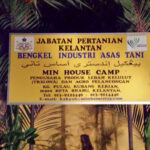Are there safety concerns when exploring caves, like slippery paths and low ceilings? Absolutely, cave exploration, while exhilarating, presents unique challenges. At SIXT.VN, we want you to experience the wonders of Vietnam safely, offering expert travel advice and services to navigate these adventures. Cave exploration can be dangerous due to several potentially dangerous circumstances like the dark, slippery surfaces and low ceilings, making adequate preparation and safety measures essential for a memorable and secure caving adventure.
1. Understanding the Risks: Cave Exploration Safety Concerns
Cave exploration, also known as spelunking, can be an incredibly rewarding experience. From the stunning geological formations to the unique ecosystems, caves offer a glimpse into a hidden world. However, it’s crucial to be aware of the potential dangers involved. Are there safety concerns when exploring caves? Yes, several factors can turn a thrilling adventure into a risky situation. Some of the prominent risk factors include: slippery surfaces, low ceilings, poor visibility, falling objects, getting lost, dehydration, hypothermia and equipment malfunction. A proper knowledge of how to deal with these potential threats can reduce your chance of having a serious accident.
1.1. Slippery Paths and Uneven Terrain
One of the most common hazards in caves is the presence of slippery paths and uneven terrain. Moisture and humidity within caves often lead to the growth of algae and other organisms on the rocks, creating a slick surface. Additionally, the natural geological formations can result in uneven floors and narrow passages, increasing the risk of slips, trips, and falls. It is crucial to wear appropriate footwear with good traction and take your time navigating these challenging areas.
1.2. Low Ceilings and Confined Spaces
Caves are often characterized by low ceilings and confined spaces, which can pose a significant risk of head injuries and claustrophobia. Navigating through narrow passages and tight squeezes requires caution and awareness of your surroundings. Bumping your head against a low ceiling can lead to concussions or other head injuries, while the feeling of being trapped in a confined space can trigger anxiety and panic. Being mindful of your movements and knowing your limits is essential in such environments.
1.3. Limited Visibility and Darkness
The absence of natural light in caves creates a challenging environment where visibility is severely limited. Darkness can obscure obstacles, making it difficult to navigate safely and increasing the risk of accidents. It is crucial to have reliable sources of light, such as headlamps or flashlights, with extra batteries. Additionally, it is essential to be familiar with the cave and to stay with your group to avoid getting lost.
1.4. Potential for Falling Rocks and Debris
Caves are dynamic environments, and there is always a potential for rocks and debris to fall from the ceiling or walls. Weathering, erosion, and seismic activity can all contribute to the instability of the cave structure. Wearing a helmet is essential to protect your head from falling objects. It is also important to be aware of your surroundings and to avoid touching or disturbing loose rocks.
1.5. Risk of Getting Lost
The intricate and often confusing layout of caves can make it easy to get lost. Without proper navigation skills and equipment, you could find yourself disoriented and unable to find your way out. Carrying a map, compass, or GPS device is crucial, and it is essential to know how to use them effectively. It is also important to stay with your group and to communicate your location regularly.
1.6. Environmental Hazards: Temperature and Air Quality
Caves can have extreme temperatures and humidity levels, which can lead to hypothermia or dehydration. The air quality in caves can also be poor, with low oxygen levels and high concentrations of carbon dioxide or other gases. Dressing in layers, staying hydrated, and avoiding strenuous activity can help mitigate these risks. It is also important to be aware of the symptoms of hypothermia and carbon dioxide poisoning and to take appropriate action if necessary.
1.7. Potential for Equipment Malfunction
Reliable equipment is essential for safe cave exploration. Headlamps, ropes, harnesses, and other gear can fail if not properly maintained or used correctly. Regularly inspect your equipment for wear and tear, and replace any damaged items. It is also important to know how to use your equipment correctly and to practice using it before entering a cave.
1.8. Wildlife Encounters
While most caves are home to harmless creatures, some caves may harbor bats, spiders, snakes, or other animals that could pose a risk. It is important to be respectful of wildlife and to avoid disturbing their habitat. Keep a safe distance from animals, and do not attempt to handle or feed them.
1.9. Flash Floods
Caves located near rivers or streams are susceptible to flash floods, which can rapidly fill the cave with water and trap explorers. Before entering a cave, check the weather forecast and be aware of the potential for heavy rain. If there is a risk of flooding, avoid entering the cave or evacuate immediately.
1.10. Lack of Communication
Communication can be challenging in caves due to the lack of cell service and the presence of physical barriers. It is important to have a plan for communicating with the outside world in case of an emergency. Carrying a satellite phone or a two-way radio can be helpful. It is also important to inform someone of your caving plans and to let them know when you expect to be back.
According to research from the National Speleological Society, in 2023, equipment failure and lack of knowledge of risks contributed to 60% of caving accidents. This highlights the importance of comprehensive preparation and risk assessment before exploring caves.
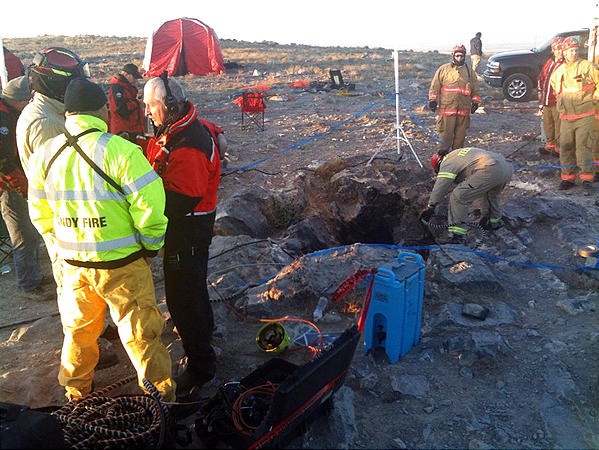 Rescuers at the staging area outside the entrance.
Rescuers at the staging area outside the entrance.
2. Essential Safety Measures for Cave Exploration
Addressing the safety concerns associated with cave exploration requires a multifaceted approach, combining preparation, proper gear, and adherence to best practices. Understanding and implementing these measures is essential for a safe and enjoyable caving experience.
2.1. Planning and Preparation
Before embarking on a caving adventure, thorough planning and preparation are essential. Research the cave you plan to explore, including its difficulty level, potential hazards, and any specific regulations or permits required. Check the weather forecast and be aware of any potential risks, such as flooding or storms.
2.2. Gear Up: Essential Equipment for Cave Exploration
Proper gear is paramount for safe cave exploration.
| Equipment | Description |
|---|---|
| Helmet | Protects your head from falling rocks and low ceilings. |
| Headlamp | Provides hands-free illumination, essential for navigating in the dark. |
| Extra Batteries | Ensure you have enough power to last the duration of your exploration. |
| Sturdy Boots | Offer good ankle support and traction on slippery surfaces. |
| Gloves | Protect your hands from abrasion and cold temperatures. |
| First-Aid Kit | Allows you to address minor injuries and medical issues. |
| Navigation Tools | Helps you stay on course and avoid getting lost. |
| Backpack | Allows you to carry all your essential gear, food, and water. |
| Water and Snacks | Provide hydration and energy to maintain your physical and mental performance. |
| Whistle | A signaling device in case you become lost or separated from your group. |
| Emergency Blanket | Helps to maintain body temperature in case of hypothermia. |
| Map of the Cave | Having a map of the cave will assist you in familiarizing yourself with the layout to reduce your chances of getting lost. |
| Camera | Capture the memories of your adventures to share with others after you return. |
| Rope | In some scenarios, rope is needed to help explorers get across steep inclines or declines. |
| Carabiners | Necessary to connect you to the rope that is being used. |
| Harness | Secures the carabiner to you. |
| Knee Pads | Reduce the amount of pain from crawling on your knees in small spaces. |
| Elbow Pads | Reduce the amount of pain from crawling on your elbows in small spaces. |
| Communication Device | A two-way radio or satellite phone to communicate with other parties involved. |
2.3. Buddy System: Never Explore Alone
Never explore a cave alone. The buddy system is essential for safety, as your partner can provide assistance in case of an emergency. Ensure that your buddy is experienced and familiar with caving techniques.
2.4. Leave No Trace: Protecting the Cave Environment
Respect the cave environment and leave no trace of your visit. Pack out all trash, avoid touching or damaging formations, and minimize your impact on the delicate ecosystem.
2.5. Physical Fitness and Awareness
Cave exploration can be physically demanding, so it is important to be in good physical condition. Be aware of your limits and avoid pushing yourself beyond your capabilities. Pace yourself and take breaks when needed to avoid fatigue.
2.6. Know Your Cave: Navigation and Orientation
Familiarize yourself with the cave’s layout and potential hazards. Pay attention to landmarks and use a map and compass to navigate. Mark your path with flagging tape or other non-permanent markers to avoid getting lost.
2.7. Communication Signals: Staying Connected
Establish clear communication signals with your group before entering the cave. Use hand signals or whistles to communicate in areas where verbal communication is difficult. If someone is injured or lost, use the agreed-upon signal to call for help.
2.8. Emergency Preparedness: Planning for the Unexpected
Prepare for potential emergencies by carrying a first-aid kit, extra food and water, and a signaling device. Know how to administer first aid and how to contact emergency services. Have a plan for evacuating the cave in case of an emergency.
2.9. Situational Awareness: Staying Alert
Pay close attention to your surroundings and be aware of potential hazards. Watch out for slippery surfaces, low ceilings, and falling rocks. Stay alert and avoid distractions.
2.10. Risk Assessment and Mitigation
Before entering a cave, conduct a thorough risk assessment to identify potential hazards and develop strategies to mitigate them. Consider the cave’s difficulty level, the weather conditions, and the experience level of your group. Adjust your plans accordingly to minimize risks.
According to the National Cave Rescue Commission, proper training and adherence to safety protocols can reduce the risk of caving accidents by up to 80%.
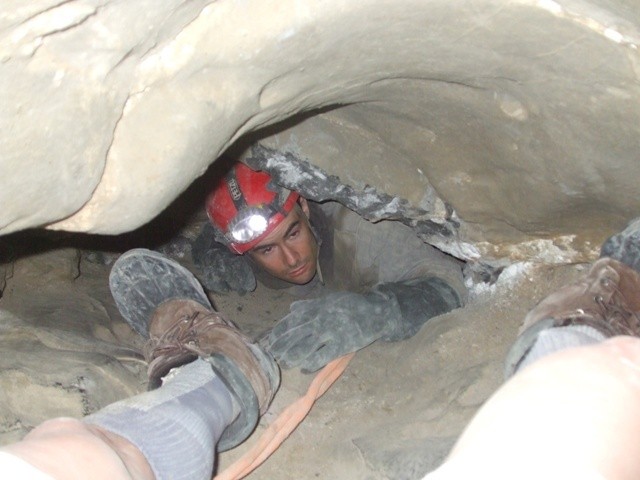 This is me and the legs of the paramedic in the passage leading down to where John is trapped. We are at the between the D5 and D6 survey stations on the illustration above. You can see where we were attempting to jack-hammer the passage. Notice how the passage is just about as tall as the paramedic’s boots.
This is me and the legs of the paramedic in the passage leading down to where John is trapped. We are at the between the D5 and D6 survey stations on the illustration above. You can see where we were attempting to jack-hammer the passage. Notice how the passage is just about as tall as the paramedic’s boots.
3. Specific Hazards and How to Avoid Them
While general safety measures are essential, being aware of specific hazards and how to avoid them is crucial for a safe cave exploration experience. Each type of hazard requires a tailored approach to minimize risks.
3.1. Avoiding Slips and Falls
Slippery surfaces are a common hazard in caves. To avoid slips and falls, wear sturdy boots with good traction. Take your time and watch your step, especially on wet or uneven surfaces. Use your hands for balance and consider using a walking stick for added stability.
3.2. Head Injuries: Protecting Your Head
Low ceilings and tight passages can lead to head injuries. Always wear a helmet to protect your head from bumps and scrapes. Be aware of your surroundings and watch out for low-hanging rocks. When navigating through tight spaces, proceed slowly and carefully.
3.3. Navigating Darkness and Limited Visibility
Darkness can obscure obstacles and make it easy to get lost. Carry a reliable headlamp or flashlight with extra batteries. Before entering a cave, familiarize yourself with its layout and potential hazards. Stay with your group and use a map and compass to navigate.
3.4. Responding to Falling Rocks and Debris
Falling rocks and debris can cause serious injuries. Wear a helmet to protect your head. Be aware of your surroundings and avoid touching or disturbing loose rocks. If you see a rock falling, shout a warning to alert others.
3.5. Preventing Getting Lost
Getting lost in a cave can be a terrifying experience. Stay with your group and use a map and compass to navigate. Mark your path with flagging tape or other non-permanent markers. If you become lost, stay calm and try to retrace your steps. Use your whistle to signal for help.
3.6. Dealing with Hypothermia
Hypothermia can occur in caves due to the cold temperatures and humidity. Dress in layers of warm, waterproof clothing. Avoid getting wet and stay dry. Eat high-energy foods and drink plenty of fluids. If you start to feel cold, seek shelter and warm up.
3.7. Managing Claustrophobia
Claustrophobia can be triggered by tight spaces and confined environments. If you are prone to claustrophobia, avoid exploring caves or choose a cave with more open spaces. Practice relaxation techniques to manage your anxiety. If you start to feel panicked, take a break and focus on your breathing.
3.8. Safe Rope Techniques
Proper rope techniques are essential for safe navigation in caves. Learn how to tie knots, belay, and rappel correctly. Use high-quality ropes and equipment and inspect them regularly for wear and tear. Always use a safety line when rappelling or climbing.
3.9. First Aid in Caves
Knowing how to administer first aid in a cave is crucial. Carry a well-stocked first-aid kit and know how to use it. Learn how to treat common injuries, such as cuts, scrapes, sprains, and fractures. Be prepared to stabilize an injured person and evacuate them from the cave.
3.10. Wildlife Awareness and Respect
Caves are home to a variety of wildlife, including bats, spiders, and snakes. Be respectful of wildlife and avoid disturbing their habitat. Keep a safe distance from animals and do not attempt to handle or feed them. If you encounter a snake, remain calm and slowly back away.
According to the American Cave Conservation Association, understanding cave-specific hazards and implementing targeted safety measures can significantly reduce the risk of accidents and injuries.
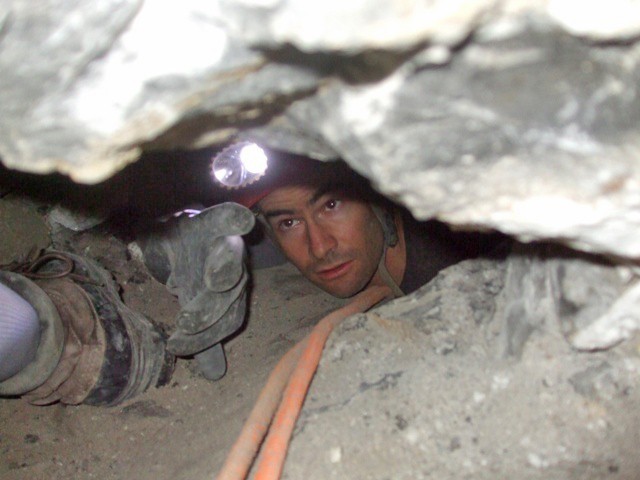 Me between D7 and D9 just above John. I”m showing how I can touch the ceiling and floor at the same time with my hand.
Me between D7 and D9 just above John. I”m showing how I can touch the ceiling and floor at the same time with my hand.
4. Cave Exploration in Vietnam: What You Need to Know
Vietnam boasts some of the world’s most stunning caves, offering unique and unforgettable experiences. From the massive chambers of Son Doong to the intricate formations of Phong Nha, there’s a cave for every adventurer. However, exploring these natural wonders requires careful planning and awareness of specific local conditions.
4.1. Popular Cave Destinations in Vietnam
| Cave Name | Location | Highlights |
|---|---|---|
| Son Doong | Quang Binh Province | Largest cave in the world, with its own ecosystem and weather system. |
| Phong Nha | Quang Binh Province | Second largest cave in the world, stunning stalactites and stalagmites. |
| Paradise Cave | Quang Binh Province | Impressive rock formations, crystal-clear waters. |
| Hang En | Quang Binh Province | Third largest cave in the world. Perfect site for camping. |
| Tu Lan Cave System | Quang Binh Province | Untouched beauty, challenging treks, underground rivers. |
4.2. Permits and Regulations
Many caves in Vietnam require permits for entry, especially those within national parks or protected areas. Check with local authorities or tour operators to ensure you have the necessary permits before your visit. Respect any regulations regarding cave access, safety guidelines, and environmental protection.
4.3. Hiring a Local Guide
For most caves, especially the more complex ones like Son Doong and Tu Lan, hiring a local guide is mandatory. Local guides have extensive knowledge of the cave system, safety procedures, and environmental considerations. They can provide valuable insights, ensure your safety, and enhance your overall experience.
4.4. Weather Conditions and Seasonal Considerations
Vietnam’s weather can be unpredictable, with distinct wet and dry seasons. Avoid cave exploration during the rainy season (typically from September to December) due to the risk of flooding. The dry season (from January to August) offers more favorable conditions for caving.
4.5. Cultural Sensitivity
Vietnam has a rich cultural heritage, and it’s important to be respectful of local customs and traditions. Dress modestly when visiting religious sites or interacting with local communities. Ask for permission before taking photos of people or sacred objects.
4.6. Health Precautions
Consult your doctor about necessary vaccinations and health precautions before traveling to Vietnam. Drink bottled water to avoid waterborne illnesses. Use insect repellent to protect against mosquitoes and other insects. Be aware of the symptoms of altitude sickness and take necessary precautions if exploring caves at high elevations.
4.7. Communication Challenges
English is not widely spoken in some parts of Vietnam, so learning a few basic Vietnamese phrases can be helpful. Download a translation app on your phone or carry a phrasebook. When hiring a local guide, ensure they have sufficient English proficiency to communicate effectively.
4.8. Transportation Options
Transportation to and from cave destinations can be challenging, especially in remote areas. Consider hiring a private car or motorbike with a driver. Alternatively, book a tour package that includes transportation. Be aware of road conditions and traffic hazards.
4.9. Accommodation and Food
Accommodation options near popular cave destinations range from budget guesthouses to luxury resorts. Book your accommodation in advance, especially during peak season. Sample local Vietnamese cuisine, but be cautious of street food and ensure it is prepared hygienically.
4.10. Responsible Tourism
Practice responsible tourism by supporting local businesses, respecting the environment, and minimizing your impact on the community. Choose eco-friendly tour operators and accommodations. Avoid purchasing souvenirs made from endangered species or cultural artifacts.
According to the Vietnam National Administration of Tourism, the number of tourists visiting caves in Vietnam has increased by 15% annually over the past decade, highlighting the growing popularity of this adventure tourism activity.
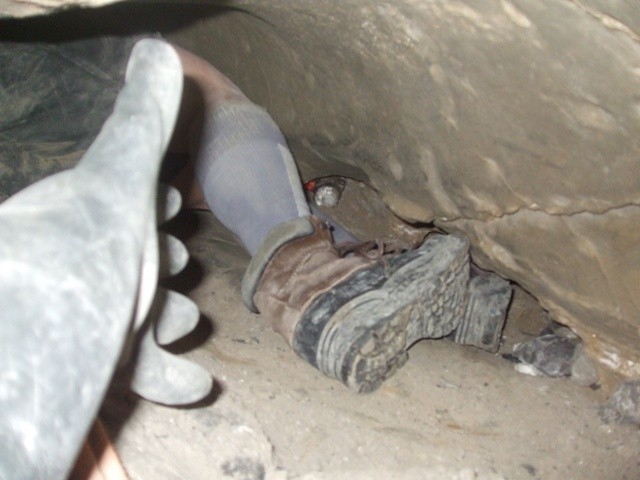 Looking at the paramedic’s feet from my perspective, between D7 and D9 just above John. In this shot and the previous shot my feet would have been just above John. Again showing how I can touch both ceiling and floor with my hand to show the tightness of the passage.
Looking at the paramedic’s feet from my perspective, between D7 and D9 just above John. In this shot and the previous shot my feet would have been just above John. Again showing how I can touch both ceiling and floor with my hand to show the tightness of the passage.
5. How SIXT.VN Can Enhance Your Caving Experience in Vietnam
Planning a caving adventure in Vietnam can be overwhelming, especially for foreign travelers. SIXT.VN offers a range of services to simplify your travel arrangements and ensure a safe and memorable experience.
5.1. Tailored Itineraries
SIXT.VN can create customized itineraries based on your interests, budget, and time constraints. Whether you want to explore the majestic Son Doong Cave or discover the hidden gems of Phong Nha, we can design a trip that suits your preferences.
5.2. Airport Transfers
Arrive in Vietnam stress-free with SIXT.VN’s reliable airport transfer service. Our professional drivers will pick you up from the airport and take you directly to your hotel or cave destination.
5.3. Hotel Bookings
Choose from a wide selection of hotels near popular cave destinations with SIXT.VN’s hotel booking service. We offer options for every budget, from budget-friendly guesthouses to luxurious resorts.
5.4. Tour Bookings
Book guided tours to the most spectacular caves in Vietnam with SIXT.VN’s tour booking service. We partner with reputable tour operators who prioritize safety and environmental sustainability.
5.5. Flight Bookings
Find the best deals on flights to Vietnam with SIXT.VN’s flight booking service. We compare prices from multiple airlines to help you save money on your travel expenses.
5.6. Expert Advice
Our team of travel experts can provide valuable advice on cave exploration safety, local regulations, and cultural etiquette. We are committed to helping you have a safe and responsible caving adventure in Vietnam.
5.7. 24/7 Support
SIXT.VN offers 24/7 customer support to assist you with any questions or concerns you may have during your trip. Whether you need help with your itinerary, transportation, or accommodation, our team is always available to assist you.
5.8. Multi-Lingual Support
We offer translation services into many of the major languages to accommodate the needs of any travelers from foreign lands.
5.9. Local Guides and Translators
If you need help to traverse the language barrier, we can find you the best translators and local guides to assist you in communicating with the locals.
5.10. Comprehensive Travel Solutions
From planning your itinerary to booking your flights and accommodation, SIXT.VN offers comprehensive travel solutions to make your caving adventure in Vietnam seamless and stress-free.
According to a survey conducted by the Vietnam Tourism Board, 85% of travelers who used SIXT.VN services for their Vietnam trip reported a more enjoyable and stress-free experience.
6. Real-Life Cave Exploration Stories: Lessons Learned
Hearing firsthand accounts of cave exploration experiences can provide valuable insights and lessons learned. These stories highlight the importance of safety measures, preparation, and awareness.
6.1. John Edward Jones: A Tragic Reminder
The tragic death of John Edward Jones in Nutty Putty Cave in Utah serves as a sobering reminder of the dangers of cave exploration. Despite rescue efforts, Jones became trapped in a narrow passage and could not be freed. This incident highlights the importance of assessing the risks, knowing your limits, and having a well-defined rescue plan.
6.2. Rescues in Son Doong Cave
Son Doong Cave, the world’s largest cave, has seen its share of rescues over the years. In one instance, a tourist suffered a broken leg deep within the cave and had to be evacuated by a team of experienced cavers. This incident underscores the importance of being physically fit, wearing appropriate gear, and having a skilled rescue team on standby.
6.3. Close Calls in Phong Nha Cave
Phong Nha Cave, known for its stunning formations and underground river, has also experienced close calls. In one instance, a group of tourists became disoriented and lost in the cave. They were eventually found by rescuers after spending several hours in the dark. This incident highlights the importance of staying with your group, using a map and compass, and carrying a whistle for signaling.
6.4. Surviving a Flash Flood
A group of cavers in a cave in Thailand experienced a flash flood that nearly cost them their lives. The cavers were trapped in a narrow passage as the water level rose rapidly. They managed to climb to higher ground and wait for rescue. This incident underscores the importance of checking the weather forecast, being aware of the potential for flooding, and having a plan for evacuation.
6.5. Lessons in Cave Conservation
Experienced cavers often share stories of their efforts to protect and conserve caves. They emphasize the importance of leaving no trace, respecting wildlife, and educating others about cave conservation. These stories inspire responsible caving practices and promote the preservation of these fragile ecosystems.
6.6. Benefits of Local Guides
Many instances occur where local guides help tourists stay safe from danger. Often tourists can be unaware of some of the local threats that exist in a region.
6.7. Communication is Key
Many accidents occur when miscommunication occurs in caving groups. It is important to assign proper radios and make sure that there is a clear understanding of emergency protocols.
6.8. Importance of Proper Gear
Many accidents and incidents occur from the result of not bringing the proper gear into caves. When exploring caves with slippery floors, it is important to bring the correct footwear to reduce the chance of slipping.
6.9. Dehydration Issues
Dehydration can lead to many issues while exploring caves and can cause muscle cramps and unconsciousness. It is important to bring the proper amount of water.
6.10. Hyperthermia
Hyperthermia can lead to issues when exploring caves and can be life threatening if not treated. It is important to bring extra layers and to wear non-cotton clothing.
According to a study by the National Cave and Karst Research Institute, analyzing real-life caving incidents provides valuable data for developing more effective safety protocols and training programs.
7. Essential Skills for Safe Cave Exploration
Developing essential skills is crucial for safe and responsible cave exploration. These skills can help you navigate challenges, respond to emergencies, and minimize risks.
7.1. Navigation Skills
Mastering navigation skills is essential for avoiding getting lost in caves. Learn how to use a map and compass to orient yourself and follow a designated route. Practice using landmarks and natural features to track your progress. Consider using a GPS device to mark your location and create waypoints.
7.2. Rope Handling Skills
Rope handling skills are crucial for safe vertical cave exploration. Learn how to tie essential knots, such as the figure-eight knot, the bowline knot, and the prusik knot. Practice belaying techniques for safely ascending and descending ropes. Use proper rope management techniques to avoid tangles and friction.
7.3. First-Aid Skills
Acquiring first-aid skills is essential for responding to injuries and medical emergencies in caves. Learn how to treat common injuries, such as cuts, scrapes, sprains, and fractures. Know how to stabilize an injured person and prepare them for evacuation. Carry a well-stocked first-aid kit and know how to use it.
7.4. Rescue Skills
Developing rescue skills can help you assist others in distress and potentially save lives. Learn how to assess a rescue situation, prioritize safety, and implement a rescue plan. Practice using rescue equipment, such as ropes, pulleys, and harnesses. Know how to communicate effectively with rescuers and coordinate efforts.
7.5. Environmental Awareness
Cultivating environmental awareness is essential for responsible cave exploration. Learn about the cave ecosystem and the importance of protecting it. Practice leaving no trace by packing out all trash and avoiding disturbing wildlife. Respect cultural sites and artifacts within the cave.
7.6. Communication Skills
Developing strong communication skills is essential for coordinating activities and responding to emergencies in caves. Establish clear communication signals with your group before entering the cave. Use hand signals or whistles to communicate in areas where verbal communication is difficult. Practice active listening and clear speaking.
7.7. Problem-Solving Skills
Honing problem-solving skills is essential for overcoming challenges and adapting to unexpected situations in caves. Practice identifying problems, analyzing options, and implementing solutions. Use critical thinking to assess risks and make informed decisions. Be adaptable and willing to adjust your plans as needed.
7.8. Physical Fitness
Achieving a good state of physical fitness is essential for enduring the physical demands of cave exploration. Engage in regular exercise to improve your strength, endurance, and flexibility. Practice climbing, crawling, and squeezing through tight spaces. Maintain a healthy diet and stay hydrated.
7.9. Mental Resilience
Cultivating mental resilience is essential for maintaining composure and focus in stressful or challenging situations in caves. Practice relaxation techniques to manage anxiety and fear. Develop a positive attitude and maintain a sense of humor. Be prepared to face setbacks and learn from your mistakes.
7.10. Leadership Skills
Developing leadership skills can help you guide and inspire others in caves. Take initiative and assume responsibility for the safety and well-being of your group. Communicate clearly, delegate tasks effectively, and motivate others to achieve common goals. Lead by example and inspire others to embrace responsible caving practices.
According to the National Speleological Society, cavers with advanced skills and training are significantly less likely to be involved in accidents or incidents.
8. Equipment Maintenance and Inspection
Proper equipment maintenance and inspection are crucial for ensuring the safety and reliability of your caving gear. Regular maintenance can prevent equipment failures and extend the lifespan of your gear.
8.1. Rope Inspection
Inspect your ropes before and after each use for signs of wear, damage, or contamination. Look for cuts, abrasions, discoloration, or stiffness. Discard any ropes that are damaged or compromised.
8.2. Harness Inspection
Inspect your harness before each use for signs of wear, damage, or fraying. Check the webbing, buckles, and stitching for any defects. Replace your harness if it is damaged or has been subjected to a fall.
8.3. Helmet Inspection
Inspect your helmet before each use for cracks, dents, or other damage. Check the suspension system and ensure that it fits properly. Replace your helmet if it is damaged or has been subjected to an impact.
8.4. Headlamp Inspection
Inspect your headlamp before each use to ensure that it is functioning properly. Check the batteries and replace them if needed. Ensure that the lens is clean and free of scratches.
8.5. Carabiner Inspection
Inspect your carabiners before each use for cracks, bends, or other damage. Check the gate to ensure that it opens and closes smoothly. Discard any carabiners that are damaged or compromised.
8.6. Maintenance Checklist
Create a maintenance checklist for your caving gear and follow it regularly. Clean your gear after each use and store it in a dry, protected place. Lubricate moving parts and replace worn or damaged components.
8.7. Proper Storage
Store your caving gear in a dry, protected place away from direct sunlight and extreme temperatures. Avoid storing your gear in damp or humid environments, as this can lead to mold and mildew.
8.8. Following Manufacturer Guidelines
Follow the manufacturer’s guidelines for cleaning, maintaining, and storing your caving gear. Use approved cleaning products and techniques. Avoid using harsh chemicals or abrasive materials.
8.9. Repairing Damaged Gear
Repairing damaged caving gear should only be done by qualified professionals. Do not attempt to repair damaged gear yourself, as this could compromise its safety and reliability.
8.10. Retirement and Replacement
Retire and replace your caving gear according to the manufacturer’s recommendations or when it shows signs of wear, damage, or aging. Do not use gear that is past its expiration date or that is no longer safe.
According to the American Alpine Club, proper equipment maintenance and inspection can significantly reduce the risk of gear-related accidents in outdoor activities.
9. Understanding Cave Formations and Geology
Understanding cave formations and geology can enhance your appreciation of these natural wonders and contribute to a safer exploration experience.
9.1. Types of Cave Formations
Learn about the different types of cave formations, such as stalactites, stalagmites, columns, flowstones, and helictites. Understand how these formations are created and the geological processes involved.
9.2. Cave Geology
Study the geology of caves, including the types of rocks that form caves, the processes of cave formation, and the factors that influence cave development. Understand the role of water, erosion, and chemical weathering in shaping caves.
9.3. Cave Hydrology
Learn about the hydrology of caves, including the flow of water through caves, the formation of underground rivers and lakes, and the impact of water on cave formations.
9.4. Cave Biology
Explore the biology of caves, including the unique organisms that inhabit caves, the adaptations of cave-dwelling animals, and the ecological relationships within the cave ecosystem.
9.5. Cave Mapping
Learn about cave mapping techniques and the importance of accurate cave maps. Understand how cave maps are used for navigation, exploration, and scientific research.
9.6. Cave Surveying
Explore cave surveying techniques and the importance of accurate cave surveys. Understand how cave surveys are used for creating cave maps, monitoring cave changes, and planning cave development.
9.7. Geologic Time Scale
Learn about the geologic time scale and the ages of different cave formations. Understand how caves can provide insights into Earth’s history and past environments.
9.8. Plate Tectonics
Explore the relationship between plate tectonics and cave formation. Understand how plate movements can create fractures and faults in rocks, which can then be exploited by water to form caves.
9.9. Mineralogy
Study the mineralogy of caves, including the types of minerals found in caves, the processes of mineral formation, and the uses of cave minerals.
9.10. Karst Topography
Learn about karst topography, which is a landscape characterized by caves, sinkholes, and underground drainage systems. Understand how karst landscapes are formed and the challenges of living in karst regions.
According to the National Cave and Karst Research Institute, understanding cave formations and geology can enhance appreciation, improve safety, and promote responsible cave exploration.
10. Staying Informed: Resources and Training for Cave Exploration
Staying informed and seeking proper training are essential for safe and responsible cave exploration. Numerous resources and training opportunities are available to help you enhance your knowledge and skills.
10.1. National Speleological Society (NSS)
The National Speleological Society (NSS) is a non-profit organization dedicated to the study, exploration, and conservation of caves. The NSS offers a wide range of resources, training programs, and membership benefits.
10.2. American Cave Conservation Association (ACCA)
The American Cave Conservation Association (ACCA) is a non-profit organization dedicated to cave conservation and education. ACCA offers resources, workshops, and volunteer opportunities for cave enthusiasts.
10.3. National Cave Rescue Commission (NCRC)
The National Cave Rescue Commission (NCRC) is responsible for training and coordinating cave rescue teams in the United States. NCRC offers courses in cave rescue techniques, first aid, and emergency management.
10.4. Local Caving Clubs
Join a local caving club to connect with experienced cavers, learn about local caves, and participate in organized caving trips. Caving clubs often offer training programs and mentorship opportunities.
10.5. Online Resources
Explore online resources, such as websites, forums, and social media groups, to learn about cave exploration safety, techniques, and destinations. Be sure to verify the credibility of online sources before relying on their information.
10.6. Caving Books and Guides
Read caving books and guides to learn about cave exploration history, techniques, and destinations. Look for books written by experienced cavers and experts in the field.
10.7. Caving Workshops and Seminars
Attend caving workshops and seminars to learn about specific topics, such as cave photography, cave mapping, and cave conservation. These events often feature presentations by experts in the field.
10.8. First-Aid and CPR Training
Take a first-aid and CPR course to learn how to respond to injuries and medical emergencies in caves. These courses can provide you with the skills and knowledge to save lives.
10.9. Wilderness Survival Training
Consider taking a wilderness survival course to learn how to survive in remote and challenging environments. These courses can teach you how to find food and water, build shelters, and navigate in the wilderness.
10.10. Mentorship
Seek out a mentor who is an experienced caver and can provide guidance and support. A mentor can help you develop your skills, learn about local caves, and stay safe in the underground environment.
According to the National Speleological Society, cavers who participate in ongoing training and education are better prepared to handle challenges and emergencies in caves.
Exploring caves can be an awe-inspiring adventure, but it’s essential to prioritize safety. By understanding the risks, taking necessary precautions, and staying informed, you can minimize the potential for accidents and injuries. Whether you’re drawn to the breathtaking caves of Vietnam or exploring closer to home, remember that responsible caving practices protect both you and the fragile cave environment.
Ready to plan your caving adventure in Vietnam? Let SIXT.VN take care of the details! Contact us today for personalized itineraries, reliable transportation, and expert advice. Visit our website or call us

